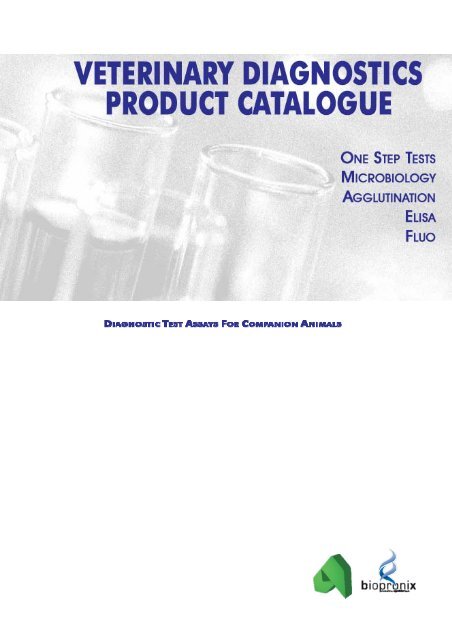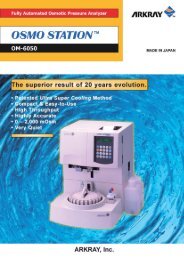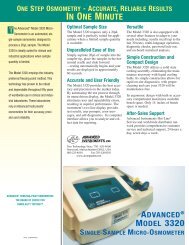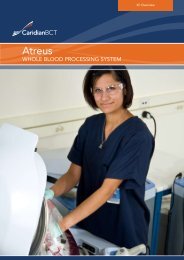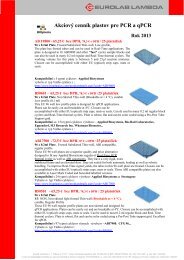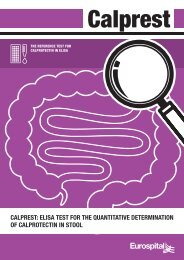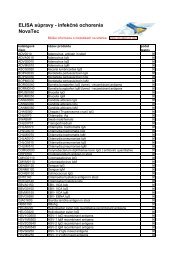Diagnostics Division of AGROLABO SpA group
Diagnostics Division of AGROLABO SpA group
Diagnostics Division of AGROLABO SpA group
Create successful ePaper yourself
Turn your PDF publications into a flip-book with our unique Google optimized e-Paper software.
<strong>Diagnostics</strong> <strong>Division</strong> <strong>of</strong> <strong>AGROLABO</strong> S.p.A. <strong>group</strong><br />
We thank you for the interest shown in our diagnostic test assays for companion animals.<br />
Founded in 1975, <strong>AGROLABO</strong>, has built a strong reputation as a leading manufacturer <strong>of</strong><br />
Diagnostic, Therapeutic and Nutritional products for veterinary application.<br />
For more than 20 years, Agrolabo has been developing, manufacturing and marketing<br />
innovative technology-based diagnostic solutions for Immunology, Immunohaematology and<br />
Infectious Diseases. The Biopronix Product Line includes a comprehensive portfolio <strong>of</strong> highquality<br />
diagnostic products, developed to provide veterinarian clinics and laboratories with<br />
efficient tools for the promotion <strong>of</strong> companion animal health care.<br />
As a leader in innovation <strong>of</strong> in vitro immunodiagnostic test systems, Agrolabo is specialised in<br />
Rapid One Step Tests, based on the immunochromatographic method (lateral flow technique),<br />
Enzyme-Linked Immunosorbent Assays (ELISA) and Immun<strong>of</strong>luorescence slides. All <strong>of</strong> our tests<br />
employ exclusively recombinant proteins and/or monoclonal antibodies as reagents. Several kit<br />
formats are available under the Agrolabo and Biopronix logos. Subject to minimum order<br />
quantities, we are also available to manufacture personalised packaging or to supply products<br />
under your own business logo.<br />
Agrolabo is fully dedicated to manufacturing innovative quality products, combining the newest<br />
technologies with the highest international standards for quality. Raw materials and finished<br />
products undergo rigorous quality controls to assure product performance and consistent<br />
optimal quality. Our company’s activities and our products are guaranteed by EN UNI ISO<br />
9001:2000 quality certification.<br />
Our commitment to developing strong and lasting relationships with our customers is at the<br />
heart <strong>of</strong> our success. We focus our efforts on meeting the needs <strong>of</strong> our customers by<br />
collaborating in an efficient and flexible way, in order to help clients to obtain the answers and<br />
results they need, by developing innovative products and carrying out quality research. We are<br />
scientist ourselves.<br />
Our products are distributed and appreciated all over the world, in countries throughout Europe,<br />
the USA and Asia. Our distributors worldwide are increasing their sales and pr<strong>of</strong>it with our kits. We<br />
would welcome you to join our growing list <strong>of</strong> satisfied customers.<br />
Agrolabo provides high quality products to all <strong>of</strong> its customers, supported by optimum<br />
assistance and service.
CATALOGUE CONTENTS<br />
One Step Tests for Cats<br />
FeLV IC & FIV IC 4<br />
FeLV/FIV IC combo 6<br />
FPV IC 7<br />
Giardia IC 8<br />
One Step Tests for Cats<br />
Distemper IC 10<br />
Ehrlichia IC 11<br />
Giardia IC 12<br />
Heartworm IC 13<br />
Leishmania IC 14<br />
Lyme IC 15<br />
Parvo IC 16<br />
Multiforumla Rapid Test Kits<br />
DDAssist Test Kits 17<br />
Rapid Microbiological Tests<br />
Dermakit 18<br />
Rapid Agglutination Tests<br />
RapidVet-H canine 20<br />
RapidVet-H feline 21<br />
ELISA TESTS 22<br />
FLUO TESTS<br />
3
Agrolabo’s IC Test Kits <strong>of</strong>fer a complete range <strong>of</strong> affordable disease testing assays that provide<br />
quality screening methods for illnesses in cats.<br />
Our rapid IC test kits for cats include single disease tests and combo disease test devices. All <strong>of</strong><br />
our rapid on-step tests have clean, easy to use testing procedures that provide test results in ten<br />
minutes. The rapid test results are clearly presented by red control and test bands that are sharp,<br />
uniform and easy to interpret.<br />
The diagnostic test kits available in our feline IC product range include FeLV IC, FIV IC, FeLV/FIV<br />
IC, FPV IC, and Giardia IC. Each kit contains convenient, cost effective, ready-to-use, highly<br />
accurate tests that help vets care for cats.<br />
Each test is available in several different packaging sizes, including boxes with 1, 2, 5, or 10 tests,<br />
as well as DDAssist multi-test kits.<br />
Common Features:<br />
o<br />
o<br />
o<br />
o<br />
o<br />
o<br />
o<br />
o<br />
o<br />
Easy to use testing procedures<br />
Colloidal gold technology<br />
Easy-to-read colour band signal with built-in test controls<br />
Clear rapid results within 10 minutes<br />
High sensitivity and specificity<br />
Choice <strong>of</strong> samples<br />
Room temperature storage<br />
Long term stability – 12 month shelf life<br />
No additional instrumentation required<br />
4
and<br />
Agrolabo’s FeLV IC and FIV IC test kits provide effective screening tools, able to provide<br />
accurate results and helpful to identify, confirm or rule out disease in cats.<br />
The FeLV IC test utilises a highly specific monoclonal antibody to test both asymptomatic and<br />
symptomatic cats for FeLV antigen, while the FIV IC test detects antibodies against the virus<br />
using a highly purified p24 recombinant protein. Both tests deliver accurate results that are<br />
easily read by the naked eye, in just 10 minutes.<br />
Available pack sizes: 1, 2, 5, 10 test kits<br />
Specific for: Cats<br />
Pathology:<br />
Feline Leukaemia Virus<br />
Method:<br />
Immunochromatographic<br />
Analyte:<br />
Antigen<br />
Capture molecules: Specific p27 monoclonal antibody<br />
Sample:<br />
Serum, plasma, whole blood<br />
Total run-time: 10 minutes<br />
Hands-on time: 1 minute<br />
Result reading: Visual<br />
Additional materials: All materials/instruments provided<br />
Storage temperature: Room temperature (18-25°C)<br />
Shelf life:<br />
12 months from production date<br />
Instructions:<br />
Multilingual<br />
Available pack sizes: 1, 2, 5, 10 test kits<br />
Specific for: Cats<br />
Pathology:<br />
Feline Immunodeficiency Virus<br />
Method:<br />
Immunochromatographic<br />
Analyte:<br />
Antibody<br />
Capture molecules: p24 recombinant protein<br />
Sample:<br />
Serum, plasma, whole blood<br />
Total run-time: 10 minutes<br />
Hands-on time: 1 minute<br />
Result reading: Visual<br />
Additional materials: All materials/instruments provided<br />
Storage temperature: Room temperature (18-25°C)<br />
Shelf life:<br />
12 months from production date<br />
Instructions:<br />
Multilingual<br />
Feline Leukemia Virus (FeLV) and Feline<br />
Immunodeficiency Virus (FIV) infections are two <strong>of</strong> the<br />
most common and fatal feline diseases worldwide. FeLV<br />
and FIV infections can cause severe immune<br />
suppression, anemia, and result in increased<br />
susceptibility to other diseases and cancers.<br />
5
Feline Leukemia Virus (FeLV) is retrovirus <strong>of</strong> the Retroviridae family causing leukemia, anemia and immunosuppression.<br />
Despite the decreasing prevalence <strong>of</strong> FeLV infections as a result <strong>of</strong> testing and vaccination programs, the disease<br />
remains the most fatal disease <strong>of</strong> cats. Feline Leukemia Virus is spread worldwide with an incidence strictly related to<br />
the density <strong>of</strong> feline populations. Infected cats transmit the FeLV infection through infected body fluids (saliva,<br />
maternal milk, faeces and urine). Transmission occurs mostly through oro-nasal contact and bite wounds. Other less<br />
frequent routes <strong>of</strong> viral spread include sharing food and water bowls, cats grooming each other, and transmission<br />
from mother to kittens before birth or during nursing. FeLV viremia can persist for many weeks, or months, without<br />
causing significant clinical signs. The progression <strong>of</strong> the disease depends on how successfully the cat’s immune<br />
system reacts to the virus. In predisposed cats, persistent viremia causes the development <strong>of</strong> associated diseases<br />
including, but not limited to, anemia, neoplasia and disorders associated with immune dysfunction.<br />
Feline Immunodeficiency Virus (FIV) is a lentivirus <strong>of</strong> domestic and wild cats found worldwide. After a long incubation<br />
period, which can last up to years, FIV infection induces an immunosuppressive disease responsible for opportunistic<br />
and secondary infections <strong>of</strong> the respiratory, gastrointestinal, urinary, cutaneous and nervous systems. Among the<br />
most important clinical signs are gingivitis/stomatitis, diarrhea, limphadenopathy, fever, anemia and leukopenia.<br />
The most common mode <strong>of</strong> transmission <strong>of</strong> FIV infections is through saliva and bite wounds. The highest rate <strong>of</strong><br />
infection is generally found in outdoor adult males (5-6 years). As the virus survives outside <strong>of</strong> the body for only a few<br />
minutes, non-aggressive contact does not appear to be an efficient route <strong>of</strong> spreading the disease. The disease is<br />
not transmitted through sexual contact; utero and neaonatal transmissions through colostrum and milk are<br />
considered uncommon.<br />
Currently, treatment <strong>of</strong> the disease is not available and infected cats die within weeks or months once symptoms<br />
appear.<br />
The most effective way to protect cats from infection with FeLV and FIV viruses is to prevent exposure to<br />
infected cats.<br />
Early detection may help maintain the health <strong>of</strong> infected cats and prevent spreading infection to other<br />
cats.<br />
It is recommended for cats to be tested for FeLV and FIV infections under the following circumstances:<br />
During sickness regardless <strong>of</strong> age, previous negative test results and vaccination status<br />
When new cats are to be introduced to a <strong>group</strong><br />
When a subject has been potentially exposed, such as though bite wounds<br />
When subjects have a history <strong>of</strong> unsupervised outdoor activity or <strong>of</strong> residing in a household with<br />
cats <strong>of</strong> unknown infection status<br />
Prior to reproduction<br />
Prior to vaccination<br />
6
The new FeLV/FIV IC two-in-one test, combines the accuracy and precision <strong>of</strong> Agrolabo’s FeLV<br />
IC and FIV IC tests in one convenient and affordable single device. With just one blood sample,<br />
veterinarians are able to screen for the two most common infectious diseases in cats.<br />
No additional training is required to carry out the assay’s easy-to-follow test procedure. Just a<br />
few drops <strong>of</strong> serum, plasma, or whole blood added to the device’s sample windows, followed<br />
by 1-2 drops <strong>of</strong> sample diluent, is required.<br />
The new FeLV/FIV IC test is easily interpretable, providing easy-to-read visual results in just 10<br />
minutes.<br />
Common features <strong>of</strong> FeLV IC and FIV IC tests:<br />
o Easy to use: two simple steps – add sample & sample buffer<br />
o Rapid: reliable in-house diagnosis in just 10 minutes, less than 1<br />
minute hands-on-time<br />
o Straightforward: easily interpretable visual results<br />
o Reliable: built-in test control confirming the correct execution <strong>of</strong> test<br />
o Choice: plasma, serum, or whole blood samples can be used<br />
o Practical: room temperature storage<br />
o Quality guarantee: high sensitivity and specificity<br />
o Long term stability:12 month shelf-life<br />
o Convenient: no additional instrumentation required<br />
o Economical: value for money in several packaging formats<br />
7
The FPV IC test is a chromatographic immunoassay designed for the qualitative detection <strong>of</strong><br />
feline panleukopenia virus (FPV) antigen in faeces samples.<br />
The development <strong>of</strong> the FPV IC test has been optimised over 10 years <strong>of</strong> diagnostic experience<br />
<strong>of</strong> this pathology. The test employs two specific monoclonal antibodies to feline panleukopenia<br />
virus to selectively identify antigen with a high degree <strong>of</strong> sensitivity.<br />
The FPV IC test is a simple in-practice test that enables veterinarians to screen for infection<br />
during a brief appointment. In less than 10 minutes, FPV IC assays provide accurate results that<br />
can be interpreted with confidence.<br />
Sensitivity: 98.4%<br />
Specificty: 100%<br />
Studies <strong>of</strong> the assay’s sensitivity show that the FPV IC test is<br />
able to detect antigen concentrations as low as 15 ng/ml.<br />
FPV IC kits provide excellent value for money. Test kits are sold in several convenient package<br />
sizes, including kits with 1, 2, 5, or 10 tests and DDAssist multi-test kits.<br />
Available pack sizes:<br />
Specific for:<br />
Pathology:<br />
Method:<br />
Analyte:<br />
Capture molecules:<br />
Sample:<br />
Total run-time:<br />
Hands-on time:<br />
Result reading:<br />
Additional materials:<br />
Storage temperature:<br />
Shelf life:<br />
Instructions:<br />
1, 2, 5, 10 test kits<br />
Cats<br />
Feline Panleukopenia Virus<br />
Immunochromatographic<br />
Antigen<br />
Monoclonal antibodies<br />
Faeces<br />
5 -10 minutes<br />
1 minute<br />
Visual<br />
All materials/instruments provided<br />
Room temperature (18-25°C)<br />
12 months from production date<br />
Multilingual<br />
8
The Giardia IC test is a rapid response in-clinic assay that allows veterinarians to run screening<br />
testing at their convenience. This carefully designed diagnostic tool accurately detects Giardia<br />
lamblia antigen in small amounts <strong>of</strong> faeces samples. Available in several kit formats, all <strong>of</strong><br />
which stored at room temperature, the Giardia IC test provides qualitative, cost-effective,<br />
ready-to-use diagnostics that can be trusted.<br />
Sensitivity: 98.4%<br />
Available pack sizes:<br />
Specific for:<br />
Pathology:<br />
Method:<br />
Analyte:<br />
Capture molecules:<br />
Sample:<br />
Total run-time:<br />
Hands-on time:<br />
Result reading:<br />
Additional materials:<br />
Storage temperature:<br />
Shelf life:<br />
Instructions:<br />
1, 2, 5, 10 test kits<br />
Cats, dogs<br />
Giardiasis<br />
Immunochromatographic<br />
Antigen<br />
Monoclonal antibodies<br />
Faeces<br />
5 -10 minutes<br />
1 minute<br />
Visual<br />
All materials/instruments provided<br />
Room temperature (18-25°C)<br />
12 months from production date<br />
Multilingual<br />
Specificty: 100%<br />
Giardia lamblia, synomymous with Lamblia intestinalis and Giardia duodenalis, is<br />
a flagellated protozoan parasite that colonises and reproduces in the small<br />
intestine, causing giardiasis. Giardia are one <strong>of</strong> the most common parasites<br />
infecting cats worldwide.<br />
Giardia cysts are the primary means <strong>of</strong> transmission from host to host. Giardia<br />
cysts are excreted in the faces <strong>of</strong> an infected cat, and then picked up when<br />
ingested by other cats sharing litter boxes. Giardia infections can also occur<br />
through ingestion <strong>of</strong> dormant cysts in contaminated water or food.<br />
Not all cats infected with Giardia will become sick. Cats may host the organism<br />
for several years, while passing it on to other cats, before showing any clinical<br />
signs <strong>of</strong> giardiasis. Younger cats are more likely to develop the disease.<br />
Giardiasis is difficult to diagnose through faecal examinations, as the protozoa are<br />
extremely small and are not passed with every stool. The microscopic<br />
identification <strong>of</strong> cysts present in faeces samples can be complex, requiring time<br />
and training. Diagnostic tools, such as rapid chromatographic immunoassays,<br />
provide simple point <strong>of</strong> care testing to assist veterinarians in the diagnosis <strong>of</strong><br />
giardiasis.<br />
The most common<br />
symptom <strong>of</strong> giardiasis is<br />
diarrhea, either with<br />
sudden onset, or <strong>of</strong> the<br />
more chronic variety. The<br />
faeces are <strong>of</strong>ten<br />
abnormal, being pale,<br />
having a bad odour, and<br />
appearing greasy. Stools<br />
may be bloody or<br />
accompanied by<br />
mucous or flatulence,<br />
and the cat may lose<br />
weight, become listless,<br />
and neglect grooming.<br />
9
Agrolabo <strong>of</strong>fers a complete range <strong>of</strong> chromatographic immunoassays designed for the<br />
qualitative detection <strong>of</strong> diseases in dogs.<br />
Agrolabo’s range <strong>of</strong> IC products <strong>of</strong>fer rapid, easy-to-use, point-<strong>of</strong>-care tests to help veterinarians<br />
identify, confirm or rule out disease in dogs.<br />
Each test is available in several different packaging sizes, including boxes with 1, 2, 5, or 10 tests,<br />
as well as DDAssist multi-test kits.<br />
Our rapid chromatographic immunoassays are high performance, cost effective tests that<br />
increase practice efficiencies and provide economic value to veterinary care pr<strong>of</strong>essionals.<br />
The diagnostic test kits available in our canine IC product range include: Distemper IC, Ehrlichia<br />
IC, Giardia IC, Heartworm IC, Leishmania IC and Parvo IC.<br />
Common Features:<br />
o<br />
o<br />
o<br />
o<br />
o<br />
o<br />
o<br />
o<br />
o<br />
Easy to use testing procedures<br />
Colloidal gold technology<br />
Easy-to-read colour band signal with built-in test controls<br />
Clear rapid results within 10 minutes<br />
High sensitivity and specificity<br />
Choice <strong>of</strong> samples<br />
Room temperature storage<br />
Long term stability – 12 month shelf life<br />
No additional instrumentation required<br />
10
Canine Distemper Virus (CDV)<br />
Canine distemper is an incurable, contagious, viral disease <strong>of</strong> dogs and other members <strong>of</strong> the<br />
canine family. It is also infective to the Mustelidae family (ferrets, mink, weasels) and the<br />
Procyonidae family (raccoons, pandas). Its aethiologic agent is a morbillivirus (Paramixoviridae<br />
family) called Canine distemper Virus (CDV). Transmission occurs by direct contact, inhalatiion<br />
and transplacentarily.<br />
Canine distemper causes very variable clinical symptoms, including lesions <strong>of</strong> the<br />
gastrointestinal, respiratory and nervous systems. Young puppies, between 3 and 6 months, are<br />
the most susceptible to infection.<br />
The incidence <strong>of</strong> canine distemper infections has reduced over recent years, however it is still<br />
present all over the world and continued vigilance is necessary to prevent a resurgence <strong>of</strong> this<br />
deadly disease. Diagnosis based on clinical<br />
symptoms, patient history, and testing is important.<br />
As prophylaxis <strong>of</strong> canine distemper is common<br />
practice, the detection <strong>of</strong> virus antigen is<br />
considered helpful for diagnosis.<br />
The DISTEMPER IC test is rapid chromatographic<br />
immunoassay that accurately detects Canine<br />
Distemper Virus (CDV) antigen in blood and mucus<br />
samples. The test employs a gold conjugate and<br />
two specific monoclonal antibodies to selectively<br />
detect antigen in just 10 minutes. The test provides<br />
clear, easy to read results that can be trusted.<br />
Sensitivity: 98.6%<br />
Specificty: 100%<br />
The evaluation <strong>of</strong> the reliability and validity<br />
<strong>of</strong> the Distemper IC test was completed<br />
through a series <strong>of</strong> studies that controlled<br />
specificity, sensitivity and correlation.<br />
Results demonstrate that the sensitivity <strong>of</strong><br />
the Distemper IC test against RT-PCR is<br />
98.6%, while specificity is 100%<br />
Available pack sizes:<br />
Specific for:<br />
Pathology:<br />
Method:<br />
Analyte:<br />
Capture molecules:<br />
Sample:<br />
Total run-time:<br />
Hands-on time:<br />
Result reading:<br />
Additional materials:<br />
Storage temperature:<br />
Shelf life:<br />
Instructions:<br />
1, 2, 5, 10 test kits<br />
Dogs<br />
Canine Distemper Virus (CDV)<br />
Immunochromatographic<br />
Antigen<br />
Specific monoclonal antibodies<br />
Serum, ocular/nasal discharge<br />
10 minutes<br />
1 minute<br />
Visual<br />
All materials/instruments provided<br />
Room temperature (18-25°C)<br />
12 months from production date<br />
Multilingual<br />
11
The EHRLICHIA IC test is a chromatographic<br />
immunoassay for the qualitative detection <strong>of</strong><br />
antibodies in samples <strong>of</strong> serum, plasma or whole<br />
blood, to aid in the diagnosis <strong>of</strong> canine Ehrlichiosis.<br />
The test employs a highly specific and purified<br />
recombinant antigen, a dominant antigen <strong>of</strong><br />
Ehrlichia canis, specifically developed to<br />
accurately detect E. canis antibodies in blood<br />
specimens.<br />
This highly reliable assay is practical and easy to<br />
use. Simply add 1 drop <strong>of</strong> serum, plasma or whole<br />
blood, followed by 1-2 drops <strong>of</strong> sample diluent to<br />
the sample test pad, and wait approximately 5<br />
minutes to read the results. Screening for infection<br />
couldn’t be easier!<br />
Available pack sizes:<br />
Specific for:<br />
Pathology:<br />
Method:<br />
Analyte:<br />
Capture molecules:<br />
Sample:<br />
Total run-time:<br />
Hands-on time:<br />
Result reading:<br />
Additional materials:<br />
Storage temperature:<br />
Shelf life:<br />
Instructions:<br />
1, 2, 5, 10 test kits<br />
Dogs<br />
Ehrlichia canis<br />
Immunochromatographic<br />
Antibody<br />
Recombinant antigen<br />
Serum, plasma, whole blood<br />
5 -10 minutes<br />
1 minute<br />
Visual<br />
All materials/instruments provided<br />
Room temperature (18-25°C)<br />
12 months from production date<br />
Multilingual<br />
Test Validation<br />
A comparative study between indirect<br />
immun<strong>of</strong>luorescence (IFA) and Ehrlichia IC, showed the<br />
following results:<br />
IFA titre 1:320 = neg. 0% - pos. 100%<br />
Canine ehrlichiosis is an infectious disease caused by Ehrlichia canis, a micro-organism that<br />
infects monoucleate cells. This organism is primarily transmitted by the Rhipicephalus<br />
sanguineus tick, the main vector and the main reservoir <strong>of</strong> infection. The disease can also be<br />
transmitted to dogs through blood transfusions.<br />
The clinical symptomatology <strong>of</strong> dogs with Ehrlichiosis is rather generic. There are two stages <strong>of</strong><br />
ehrlichiosis, each varying in severity. The acute phase <strong>of</strong> the disease is not usually life<br />
threatening and infected animals will either become asymptomatic carriers, or progress to the<br />
chronic stage. The chronic phase represents a stage <strong>of</strong> infection in which the animal may<br />
show signs <strong>of</strong> lameness, neurological and ophthalmic disorders, kidney disease, and anemia<br />
and other blood disorders.<br />
Diagnosis is achieved most commonly by serologic testing <strong>of</strong> the blood for the presence <strong>of</strong><br />
antibodies against the Ehrlichia organism. Such testing is important during the chronic phase<br />
<strong>of</strong> the illness.<br />
12
The GIARDIA IC test is a rapid response in-clinic assay that allows veterinarians to run screening<br />
testing at their convenience. This carefully designed diagnostic tool accurately detects Giardia<br />
lamblia antigen in small amounts <strong>of</strong> faeces samples. Available in several kit formats, all <strong>of</strong><br />
which stored at room temperature, the Giardia IC test provides qualitative, cost-effective,<br />
ready-to-use diagnostics that can be trusted.<br />
Sensitivity: 98.4%<br />
Available pack sizes:<br />
Specific for:<br />
Pathology:<br />
Method:<br />
Analyte:<br />
Capture molecules:<br />
Sample:<br />
Total run-time:<br />
Hands-on time:<br />
Result reading:<br />
Additional materials:<br />
Storage temperature:<br />
Shelf life:<br />
Instructions:<br />
1, 2, 5, 10 test kits<br />
Cats, dogs<br />
Giardiasis<br />
Immunochromatographic<br />
Antigen<br />
Monoclonal antibodies<br />
Faeces<br />
5 -10 minutes<br />
1 minute<br />
Visual<br />
All materials/instruments provided<br />
Room temperature (18-25°C)<br />
12 months from production date<br />
Multilingual<br />
Specificty: 100%<br />
Giardia lamblia, synomymous with Lamblia intestinalis and Giardia duodenalis, is<br />
a flagellated protozoan parasite that colonises and reproduces in the small<br />
intestine, causing giardiasis. Giardia are one <strong>of</strong> the most common parasites<br />
infecting dogs worldwide.<br />
Giardia infections are primarily transmitted through the faecal-oral route, via<br />
ingestion <strong>of</strong> the trophocoites or cysts in contaminated food, water, or the<br />
environment. It is suggested that ingestion <strong>of</strong> as few as one or more Giardia cysts<br />
may cause the disease.<br />
Not all dogs infected with Giardia will become sick. Dogs may host the organism<br />
for several years, while passing it on to other dogs, before showing any clinical<br />
signs <strong>of</strong> giardiasis. Puppies, immunodepresed dogs and dogs with multiple<br />
parasite infections are more likely to develop the clinical signs associated with the<br />
disease.<br />
Giardiasis is difficult to diagnose through faecal examinations, as the protozoa are<br />
extremely small and are not passed with every stool. The microscopic<br />
identification <strong>of</strong> cysts present in faeces samples can be complex, requiring time<br />
and training. Diagnostic tools, such as rapid chromatographic immunoassays,<br />
provide simple point <strong>of</strong> care testing to assist veterinarians in the diagnosis <strong>of</strong><br />
giardiasis.<br />
The most common<br />
symptom <strong>of</strong> giardiasis is<br />
diarrhea, either with<br />
sudden onset, or <strong>of</strong> the<br />
more chronic variety. The<br />
faeces are <strong>of</strong>ten<br />
abnormal, being pale,<br />
having a bad odour, and<br />
appearing greasy. Stools<br />
may be bloody or<br />
accompanied by<br />
mucous or flatulence,<br />
and the cat may lose<br />
weight, become listless,<br />
and neglect grooming.<br />
13
Heartworm disease is caused by the parasite Dir<strong>of</strong>ilaria immitis, transmitted by at least 70<br />
different genera <strong>of</strong> mosquitos, <strong>of</strong> which Aedes, Anopheles and Culex are the most common.<br />
The disease is reported in most temperate, semitropical and tropical countries. In dogs the<br />
greatest risk is for animals housed outdoors, medium- to large-sized, 3 to 8 years old.<br />
The HEARTWORM IC test is a chromatographic immunoassay designed for the qualitative<br />
detection <strong>of</strong> Dir<strong>of</strong>ilaria immitis antigen in blood samples.<br />
The development <strong>of</strong> the Heartworm IC test has been optimised over 10 years <strong>of</strong> diagnostic<br />
experience <strong>of</strong> this pathology. The test employs highly specific monoclonal antibodies to<br />
selectively identify circulating D. immitis antigen with a high degree <strong>of</strong> accuracy.<br />
The Heartworm IC test is a simple in-practice test that enables veterinarians to screen for<br />
infection during a brief appointment. In less than 10 minutes, Heartworm IC assays provide<br />
accurate results that can be interpreted with confidence.<br />
Sensitivity: 100%<br />
Specificty: 98.8%<br />
Validation studies demonstrate that the Heartworm IC test is<br />
highly sensitive and has a high correlation level with<br />
commercially available ELISA tests.<br />
Heartworm IC kits provide excellent value for money. Test kits are sold in several convenient<br />
package sizes, including kits with 1, 2, 5, or 10 tests and DDAssist multi-test kits.<br />
Available pack sizes:<br />
Specific for:<br />
Pathology:<br />
Method:<br />
Analyte:<br />
Capture molecules:<br />
Sample:<br />
Total run-time:<br />
Hands-on time:<br />
Result reading:<br />
Additional materials:<br />
Storage temperature:<br />
Shelf life:<br />
Instructions:<br />
1, 2, 5, 10 test kits<br />
Dogs<br />
Heartworm disease<br />
Immunochromatographic<br />
Antigen<br />
Monoclonal antibodies<br />
Plasma, serum, whole blood<br />
5 -10 minutes<br />
1 minute<br />
Visual<br />
All materials/instruments provided<br />
Room temperature (18-25°C)<br />
12 months from production date<br />
Multilingual<br />
14
The LEISHMANIA IC test is a chromatographic<br />
immunoassay for the qualitative detection <strong>of</strong><br />
antibodies in samples <strong>of</strong> serum, plasma or whole<br />
blood, to aid in the diagnosis <strong>of</strong> canine<br />
Leishmaniasis. The test employs highly purified<br />
antigen, specific to Leishmania (promastigote<br />
stage), to accurately detect antibodies in blood<br />
specimens.<br />
This highly reliable assay is practical and easy to<br />
use in any consulting room, providing for affordable<br />
screening testing at the vet’s convenience!<br />
Available pack sizes:<br />
Specific for:<br />
Pathology:<br />
Method:<br />
Analyte:<br />
Capture molecules:<br />
Sample:<br />
Total run-time:<br />
Hands-on time:<br />
Result reading:<br />
Additional materials:<br />
Storage temperature:<br />
Shelf life:<br />
Instructions:<br />
1, 2, 5, 10 test kits<br />
Dogs<br />
Leishmaniasis<br />
Immunochromatographic<br />
Antibody<br />
Specific antigen<br />
Serum, plasma, whole blood<br />
5 -10 minutes<br />
1 minute<br />
Visual<br />
All materials/instruments provided<br />
Room temperature (18-25°C)<br />
12 months from production date<br />
Multilingual<br />
Test Validation<br />
Several validation studies have been carried out on the<br />
Leishmania IC test, including comparative studies with<br />
other commercial tests, with a panel <strong>of</strong> samples from<br />
different regions, with ELISA tests and with other rapid<br />
tests. Each study showed a high level <strong>of</strong> specificity and<br />
sensitivity.<br />
Leishmaniasis is a chronic protozoal disease which affects dogs and humans. The main<br />
clinical symptons <strong>of</strong> the disease include mucocutaneous lesions, weight loss,<br />
lymphadenopathy, anemia, joint pains, liver failure, nervous and ocular damage. The<br />
disease is particularily widespread in the Mediterranean coastal areas and is spreading to<br />
surrounding inland regions with temperate climates, where vectors <strong>of</strong> leishmaniasis, different<br />
species <strong>of</strong> phlebotomine flies (hematophagous insects), are found. .<br />
The etiological agents <strong>of</strong> leishmaniasis are the Leishmania infantum and L. donovani<br />
protozoans, which are transmitted in their promastigote stage by phlebotomine sand flies,<br />
small dipterous hematophagous insects, similar to mosquitoes.<br />
The incubation period <strong>of</strong> the disease, which varies from 3 months to several years, is followed<br />
by the appearance <strong>of</strong> variable symptoms which evolve slowly and progressively. These<br />
include cutaneous lesions, anemia, general lymphadenopathy, ocular lesions, liver and<br />
kideny failure, limping and chronic enteritis. The most evident cutaneous lesions include<br />
alopecia, furfuraceous desquamation, ulcers on the head and limbs.<br />
Therapy is approached through the use <strong>of</strong> derivatives <strong>of</strong> antimonate and allopurinol. All<br />
antileishmania drugs are toxic and relapses are frequent. The mainstay <strong>of</strong> prevention <strong>of</strong><br />
canine leishmanaisis includes controlling populations <strong>of</strong> stray dogs (reservoirs <strong>of</strong> infection) and<br />
insecticidal treatments. An effective vaccine against leishmaniasis does not exist.<br />
15
The LYME IC test is a ready-to-use assay that provides clear, easy-to-interpret screening results in<br />
under 10 minutes. This carefully designed diagnostic tool accurately detects antibodies to<br />
Borrelia burgdorferi in small amounts <strong>of</strong> canine sera. Available in several kit formats, all <strong>of</strong> which<br />
stored at room temperature, the LYME IC test provides qualitative, cost-effective, in-house<br />
diagnostics that can be trusted.<br />
Sensitivity: 90%<br />
Available pack sizes:<br />
Specific for:<br />
Pathology:<br />
Method:<br />
Analyte:<br />
Capture molecules:<br />
Sample:<br />
Total run-time:<br />
Hands-on time:<br />
Result reading:<br />
Additional materials:<br />
Storage temperature:<br />
Shelf life:<br />
Instructions:<br />
1, 2, 5, 10 test kits<br />
dogs<br />
Lyme disease<br />
Immunochromatographic<br />
Antibody<br />
Purified antigen<br />
Plasma, serum, whole blood<br />
5 -10 minutes<br />
1 minute<br />
Visual<br />
All materials/instruments provided<br />
Room temperature (18-25°C)<br />
12 months from production date<br />
Multilingual<br />
Specificty: 98.6%<br />
Borreliosis (or Lyme disease) is an arthropode-born, bacterial disease <strong>of</strong> man and<br />
animals; among these the most affected are the dogs.<br />
The causative agent is a spirochete, Borrelia burgdorferi, whose vectors are ticks<br />
<strong>of</strong> the species Ixodes ricinus; both larvae and nymphs acquire the infection by<br />
feeding on infected reservoir hosts (primarily small mammals as small wild<br />
rodents) and transmitting the infection to the subsequent hosts; the highest<br />
incidence is observed in spring and autumn.<br />
Therapy is based on the administration <strong>of</strong> antibiotics (penicillin and tetracycline),<br />
usually followed by a rapid regression <strong>of</strong> symptoms (primarily in joints) <strong>of</strong> most<br />
animals. A limited number <strong>of</strong> animals show persistence <strong>of</strong> infection in spite <strong>of</strong> the<br />
antibiotic therapy. A symptomatic therapy must be considered, especially for the<br />
renal, cardiac and neurologic syndromes, with administration <strong>of</strong> non-steroidal<br />
anti-inflammatory drugs in case <strong>of</strong> swollen and painful joints.<br />
Prophylaxis is based on avoidance <strong>of</strong> contacts with ticks and applications <strong>of</strong> tick<br />
control products or collars. For the dog is available an inactivated vaccine, to be<br />
administered at 12 weeks <strong>of</strong> age, again after 3 to 5 weeks, and annually.<br />
The most common<br />
symptoms <strong>of</strong> Lyme disease<br />
in dogs are: fever, anorexia,<br />
lethargy, lameness with<br />
swollen joints and<br />
lymphadenopathy. In renal<br />
borreliosis, generally fatal,<br />
uremia, proteinuria, ascites<br />
and edema are usually<br />
observed. The cardiac form<br />
is accompanied by<br />
conduction abnormalities<br />
and bradycardia, while in<br />
the neurologic form the<br />
most common symptoms<br />
are represented by facial<br />
paralysis and seizures.<br />
16
The PARVO IC test is a rapid response chromatographic immunoassay designed for the<br />
qualitative detection <strong>of</strong> canine Parvovirus (CPV) antigen in faeces samples. The test employs<br />
specific monoclonal antibodies marked with colloidal gold, against canine parvovirus to<br />
selectively identify antigen with a high degree <strong>of</strong> accuracy.<br />
The PARVO IC test is a simple in-practice test that provides accurate results in less than 10<br />
minutes. Each test includes an easy-to-read colour band signal with built-in test control that can<br />
be interpreted with confidence. PARVO IC test kits are sold in several convenient package sizes,<br />
including kits with 1, 2, 5, or 10 tests and DDAssist multi-test kits, containing all the necessary<br />
materials for testing.<br />
Test validation<br />
The evaluation <strong>of</strong> the test’s reliability and validity was completed through a series <strong>of</strong> studies that checked<br />
specificity, sensitivity and correlation.<br />
The first study examined the test’s sensitivity. The target aim <strong>of</strong> the test’s development was to create a test<br />
able to detect positivity <strong>of</strong> a patient before clinical symptoms. The evaluation <strong>of</strong> sensitivity was realised<br />
preparing different dilutions <strong>of</strong> viral particles. The highest dilution determined by the PARVO IC test was 15<br />
ng/ml.<br />
The sensitivity value makes the PARVO IC test a valid screening test to be used both for diagnosis and for<br />
prevention as a routine control system, above all on new born puppies considering that the detecting<br />
value is shown in faeces in 2-4 days from infection.<br />
The second study was carried out in correlation between the PARVO IC test, the ELISA technique and<br />
cellular culture and agglutination test. In this study 142 samples, from animals with and without symptoms,<br />
were studied (from Veterinary University <strong>of</strong> Madrid, Spain).<br />
Results show that the sensitivity and specificity <strong>of</strong> the PARVO IC test is extremely high.<br />
Available pack sizes:<br />
Specific for:<br />
Pathology:<br />
Method:<br />
Analyte:<br />
Capture molecules:<br />
Sample:<br />
Total run-time:<br />
Hands-on time:<br />
Result reading:<br />
Additional materials:<br />
Storage temperature:<br />
Shelf life:<br />
Instructions:<br />
1, 2, 5, 10 test kits<br />
Dogs<br />
Canine Parvovirus (CPV)<br />
Immunochromatographic<br />
Antigen<br />
Monoclonal antibodies<br />
Faeces<br />
5 -10 minutes<br />
1 minute<br />
Visual<br />
All materials/instruments provided<br />
Room temperature (18-25°C)<br />
12 months from production date<br />
Multilingual<br />
17
Go the extra mile in competitive times, personalising products to suit your customers’<br />
preferences with Agrolabo’s new DDAssist test kit. This new multi-formula kit enables you<br />
to design products containing any combination <strong>of</strong> five single/2 test kits in an attractive<br />
product presentation.<br />
Products available to create DDAssist Kits:<br />
Product Code No. Tests<br />
Distemper IC<br />
27278891 1 test<br />
27278802 2 tests<br />
Ehrlichia IC<br />
27279191 1 test<br />
27279102 2 tests<br />
FeLV IC<br />
27224791 1 test<br />
27224702 2 tests<br />
FIV IC<br />
27224391 1 test<br />
27224302 2 tests<br />
FeLV/FIV IC<br />
27224891 1 test<br />
27224802 2 tests<br />
FPV IC<br />
27224061 1 test<br />
27224062 2 tests<br />
Giardia IC<br />
27238091 1 test<br />
27238002 2 tests<br />
Heartworm IC<br />
27236091 1 test<br />
27236002 2 tests<br />
Leishmania IC<br />
2n270191 1 test<br />
2n270102 2 tests<br />
Lyme IC<br />
27281091 1 test<br />
27281002 2 tests<br />
Parvo IC<br />
27224091 1 test<br />
27224002 2 tests<br />
Single/2 test kit packaging<br />
DDAssist Test Kit packaging containing<br />
five single/2 test kits<br />
18
A fast, simple and easy to perform test which enables the busy non-mycologist veterinarian to<br />
confirm the diagnosis <strong>of</strong> dermatophyte infections.<br />
Available pack sizes: 12 test kits<br />
Specific for: Cat, Dogs, Horses<br />
Pathology:<br />
Dermatophytosis<br />
Apperance: Upright glass bottle with screw-cap lid<br />
Culture response: E. floccosum, M. audouini, M.canis, M. gypseum, T.<br />
mentagrophytes, T.Rubrum, and T. Tonsurans fungi<br />
colony growth<br />
Sample:<br />
Animal hair or skin scrapings from lesion boarder<br />
Hands-on time: Approximately 3 minutes<br />
Incubation:<br />
At room temperature<br />
Result reading: Visual; pH colour marker changes medium<br />
colour<br />
from 72 hours indicating a positive result<br />
Additional materials: Scapel or brush<br />
Storage temperature: Room temperature or refrigerated<br />
Shelf life:<br />
36 months when stored in a refrigerator,<br />
24 months when stored at room temperature<br />
Instructions: English<br />
Test Description:<br />
DERMAKIT, developed by Agrolabo S.p.A., is a selective and differential medium for the<br />
detection and presumptive identification <strong>of</strong> dermatophytes from veterinary specimens.<br />
DERMAKIT is a Dermatophyte Selective Medium (DSM) based on the original Dermatophyte Test<br />
Medium (DTM) developed by Taplin et al. The new DSM formula developed by Agrolabo,<br />
reduces the time required to obtain results and increases the product’s shelf life to 36 months.<br />
Furthermore, Agrolabo’s fungus culture agar is more specific and is, therefore, less prone to<br />
common contamination. The medium can also be incubated at room temperature, without<br />
having to be placed in a dark area, or without having to take precautions so as to prevent<br />
dehydration <strong>of</strong> the media.<br />
19
Dermatophytosis is the most common infectious skin disease <strong>of</strong> small animals. Puppies, kittens and debilitated<br />
pets are the most susceptible to dermatophytosis.<br />
Dermatophytosis, generally referred to as tinea or ringworm, is a cutaneous infection caused by different genera<br />
<strong>of</strong> fungi collectively called the ‘dermatophytes’. The main fungi responsible for dermatophytosis in domestic<br />
animals are Microsporum canis, Microsporum gypseum and Trichophyton mentagrophytes. These pathogenic<br />
fungi are found worldwide.<br />
Dermatophytosis is a zoonotic skin disease. Children, the elderly and immunocompromised people are special<br />
at-risk populations, but anyone in frequent contact with infected pets risks contracting the disease.<br />
Dermatophytosis is in fact highly contagious.<br />
Dermatophytes can be found on animals, on humans and in the environment in the form <strong>of</strong> hyphae and spores.<br />
Dermatophytes metabolise the keratine <strong>of</strong> skin, hair and claws, and initially invade the intrafollicular skin area.<br />
Pets should be tested for dermatophytosis:<br />
• when clinical signs compatible with the disease are apparent.<br />
• when an animal has skin disease, in order to confirm, or eliminate, the diagnosis <strong>of</strong> a dermatophyte<br />
infection.<br />
• when a pet owner develops skin disease and there is the possibility that the pet could be the source.<br />
• during treatment for dermatophyte infections, in order to monitor therapy and to help prevent reinfection.<br />
• as routine testing for, pets newly acquired from a breeding facility, cats that habitually go outside <strong>of</strong> the<br />
home, domestic animals that ‘work’ in close contact with humans.<br />
20
CANINE BLOOD GROUP DETERMINATION<br />
AGGLUTINATION TEST<br />
Identification <strong>of</strong> the DEA 1.1 blood <strong>group</strong><br />
RapidVet-H canine kits are the first commercially available in-house tests for blood typing dogs.<br />
This pratical and easy-to-use tests enables veterinarians to quickly determine if a dog is blood<br />
type DEA 1.1 positive or negative in any consulting room, or even under field conditions.<br />
Available in several kit formats, 1, 5 or 20 tests, RapidVet-H canine kits provide qualitative, costeffective,<br />
ready to use diagnostics that can be trusted. All materials required for performing the<br />
test are including in the kits.<br />
Dog Erythrocyte Antigen (DEA) is the internationally accepted canine blood <strong>group</strong> system.<br />
Among the 8 antigens identified on the surface <strong>of</strong> the canine erythrocytes, DEA 1.1 is the most<br />
antigenic and thus the most important.<br />
Dogs that are DEA 1.1 positive can be considered to be universal recipients - that is, they can<br />
receive blood <strong>of</strong> any type without expectation <strong>of</strong> a life-threatening Hemolytic Transfusion<br />
Reaction ("HTR").<br />
Dogs that are DEA 1.1 negative can be considered to be universal donors. Blood from DEA 1.1<br />
positive dogs on the other hand, should never be transfused into DEA 1.1 negative dogs. The red<br />
cells transfused during the first transfusion will have a shortened life due to the formation <strong>of</strong><br />
alloantibodies to the cells themselves and the animal will become sensitised to DEA 1.1 blood. In<br />
the event <strong>of</strong> a second such transfusion, life-threatening conditions will follow within hours. In<br />
addition, these alloantibodies will be present in colostrum and adversely affect the health <strong>of</strong> DEA<br />
1.1 negative puppies.<br />
Why should dogs be blood typed?<br />
• Good medical practice: blood typing dogs at their first<br />
physical examination provides valuable knowledge in<br />
advance <strong>of</strong> need.<br />
• Transfusions: all canine transfusion donors and<br />
recipients should be typed for DEA 1.1, so as not to<br />
sensitise the recipient animal or decrease the life <strong>of</strong> the<br />
transfused red cells.<br />
RapidVet-H single test kit packaging<br />
• Transfusion recipients: all recipient dogs that have been<br />
previously transfused must be typed for DEA 1.1, in order<br />
to avoid life-threatening reactions in the recipient dog.<br />
• Breeding: blood typing can provide useful information in choosing breeding partners. All<br />
pregnant dogs should be blood typed and evaluated<br />
hematologically for alloantibodies and their puppies should<br />
be blood typed at birth.<br />
• It's logical -- just as the owner's blood type is known and<br />
documented, so should the dog's blood type be known and<br />
documented. If a dog is valuable enough to register, it<br />
should certainly have a complete medical "passport",<br />
including its blood type.<br />
RapidVet-H 5/20 test kit packaging<br />
21
FELINE BLOOD GROUP DETERMINATION<br />
AGGLUTINATION TEST<br />
Identification <strong>of</strong> A, B, and AB blood <strong>group</strong>s<br />
The RapidVet-H feline card is the first commercially available in-house test for accurately<br />
classifying Type A, Type B or Type AB blood <strong>group</strong>s in cats. This practical and easy-to-use tests<br />
enables veterinarians to quickly determine a cat’s blood type in any consulting room, or even<br />
under field conditions, reducing the risks related to transfusions and hemolytic anemia.<br />
Available in several kit formats, 1, 5 or 20 tests, RapidVet-H feline kits provide qualitative, costeffective,<br />
ready to use diagnostics that can be trusted. All materials required for performing the<br />
test are including in the kits.<br />
RapidVet-H feline tests are based on an agglutination reaction that occurs when an erythrocyte containing<br />
either a type A, B, or AB antigen on its surface membrane, interacts with a lyophilised antiserum specific to the<br />
particular antigen.<br />
Type B cats have high specific antibody titre <strong>of</strong> type A blood. Rapid-Vet-H (Feline) kit uses these antibodies to<br />
recognize type A blood. The antibody molecule links and agglutinates the specific antigen <strong>of</strong> type A blood.<br />
Type A cats have low antibody titre <strong>of</strong> type B blood. The antiserum from type A cats cannot be used to develop<br />
a test sensitive to type B blood. Type B erythrocytes are characterized by Neu Ac2 G D3 form <strong>of</strong> neuraminic<br />
acid present in ganglioside and Neu Gc, present in type A erythrocytes, are not present. The specific link <strong>of</strong> this<br />
form with Lectin, Triticum Vulgaris is well known. The Rapid-Vet-H (Feline) kit uses lectin Triticum Vulgaris to show<br />
the presence <strong>of</strong> type B blood.<br />
In both cases, antiserum lyophilized on the card are reconstituted and mixed with whole blood from the patient.<br />
All type A erythrocytes react with their specific antiserum causing agglutination: all type B erythrocytes react in a<br />
similar way; all type AB erythrocytes reacts with both antiserum and agglutination will occur in any case. Results<br />
may be visually read.<br />
What are the risks <strong>of</strong> not blood typing cats?<br />
Transfusion Risks<br />
If cats are transfused, even once, with an incompatible blood type, a<br />
Hemolytic Transfusion Reaction ("HTR") will occur, resulting nearly<br />
always in death.<br />
Mating Risks<br />
Most <strong>of</strong> the kittens <strong>of</strong> an A(female)/B(male) mating will have A blood<br />
type. A high percentage <strong>of</strong> these kittens will <strong>of</strong>ten die suddenly after<br />
nursing in what is known as Fading Kitten Syndrome or Neonatal<br />
Isoerythrolysis ("NI"). In mating with a B type Queen, where the Tom is carefully chosen (B type), no risks are<br />
involved. However, where the Tom and Queen have incompatible blood types, their A type kittens will<br />
probably die unless they are removed from the mother immediately at birth and surrogate nursed.<br />
The conclusions are clear:<br />
• All cats should be routinely blood typed.<br />
• No cats should be mated before blood typing.<br />
• All kittens <strong>of</strong> incompatible matings should be blood typed at birth so that surrogate nursing can be<br />
started where necessary and the kittens allowed to thrive.<br />
22
The enzyme-linked immunosorbent assay (ELISA) is a common serological test for the presence<br />
<strong>of</strong> particular antigens or antibodies. Agrolabo manufacutures a series <strong>of</strong> direct ELISA kits,<br />
employing monoclonal antibodies to detect the presence <strong>of</strong> a particular antigen in a sample,<br />
and indirect ELISA kits, determining the presence <strong>of</strong> a specific antibody in a specimen such as<br />
serum.<br />
Agrolabo’s ELISA tests are highly sensitive and specific, designed specifically for screening large<br />
numbers <strong>of</strong> specimens at a time. Although some training is required to perform ELISA testing,<br />
Agrolabo’s ELISA tests are practical and easy to perform. Additional equipment, such as a plate<br />
reader may be required.<br />
Available ELISA test kits include:<br />
Coronavirus Ab ELISA Code No. Wells<br />
ELISA kit for the detection <strong>of</strong><br />
antibodies to Coronavirus<br />
Distemper IgM ELISA<br />
27259001<br />
Code<br />
96 wells<br />
No. Wells<br />
ELISA kit for the detection <strong>of</strong><br />
IgM antibodies to Distemper<br />
Distemper IgG ELISA<br />
27279062<br />
Code<br />
96 wells<br />
No. Wells<br />
ELISA kit for the detection <strong>of</strong><br />
IgG antibodies to Distemper<br />
Ehrlichia canis Ab ELISA<br />
27279052<br />
Code<br />
96 wells<br />
No. Wells<br />
ELISA kit for the detection <strong>of</strong><br />
antibodies to Ehrlichia canis<br />
FeLV Ag ELISA<br />
27279296<br />
Code<br />
96 wells<br />
No. Wells<br />
ELISA kit for the detection <strong>of</strong> 27224701 32 wells<br />
FeLV antigen 27224732 96 wells<br />
FeLV Anti GP70 Ab ELISA Code No. Wells<br />
ELISA kit for the detection <strong>of</strong><br />
Anti GP70 antibodies to FeLV<br />
FILARCHECK ELISA<br />
27224764<br />
Code<br />
96 wells<br />
No. Wells<br />
ELISA kit or the detection <strong>of</strong> 27236348 48 wells<br />
Dir<strong>of</strong>ilaria immitis antigen 27236396 96 wells<br />
FIV Ab ELISA Code No. Wells<br />
ELISA kit for the detection <strong>of</strong> 27224301 32 wells<br />
antibodies to FIV 27224332 96 wells<br />
Leishmania ELISA Code No. Wells<br />
ELISA kit for the detection <strong>of</strong><br />
antibodies to Leishmania<br />
Parvo Ab ELISA<br />
27270101<br />
Code<br />
96 wells<br />
No. Wells<br />
ELISA kit for the detection <strong>of</strong><br />
antibodies to Parvovirus<br />
Parvo Ag ELISA<br />
27224096<br />
Code<br />
96 wells<br />
No. Wells<br />
ELISA kit for the detection <strong>of</strong><br />
Parvovirus antigen<br />
27224032 96 wells<br />
23
Immun<strong>of</strong>luorescence was first used more than fifty years ago and is now a common laboratory<br />
technique used to examine individual proteins that are in a preserved cell. It can determine<br />
both the location and relative quantity <strong>of</strong> a specific protein. Antibodies are used that<br />
specifically recognize and bind to the protein <strong>of</strong> interest. These antibodies contain a fluorescent<br />
tag that absorbs light and emits it at a different wavelength. The fluorescence is then analyzed<br />
under a fluorescent microscope and the resulting signal corresponds to the protein's location.<br />
Antibody detection:<br />
Agrolabo’s immun<strong>of</strong>luorescence kits detect Immunoglobulin G (IgG), the most abundant<br />
immunoglobulin which appear circa 40 days following exposure to antigen.<br />
Packaging:<br />
We supply 10 slide kits (including reagents), packages <strong>of</strong> 10 slides (without reagents) and<br />
packages <strong>of</strong> 50 slides (without reagents). Each slides contains 10 or 12 wells, depending on the<br />
pathology. The slides employed for test production have been specifically chosen for their<br />
quality and homogeneity. As part <strong>of</strong> our quality control process special attention is paid to the<br />
distribution <strong>of</strong> the wells and their shaping.<br />
Just as we are able to supply slides separately, we can also supply reagents separately.<br />
The slides are not species specific and thus for those pathologies that are diffused in more than<br />
one animal species, different reagents can be supplied according to the species.<br />
Fluorescence:<br />
Our slides label positive samples with green fluorescent dyes and negative samples with red<br />
fluorescent dyes. This combination <strong>of</strong> colours facilitates reading as the two colours are very<br />
distinct.<br />
Please see overleaf for a list <strong>of</strong> available Fluo slides and kits.<br />
24
FLUO TESTS for cats, dogs and horses<br />
Immun<strong>of</strong>luorescence slides and kits<br />
Bartonella henselae Fluo Code Packaging<br />
12 well immun<strong>of</strong>luorescence slides 27266001 10 slide kit<br />
for the detection <strong>of</strong> IgG antibodies 27266010 10 slides<br />
to Bartonella henselae in cat serum 27266050 50 slides<br />
Calicivirus Fluo Code Packaging<br />
10 well immun<strong>of</strong>luorescence slides 27262901 10 slide kit<br />
for the detection <strong>of</strong> IgG antibodies 27262910 10 slides<br />
to calicivirus in cat serum 27262950 50 slides<br />
Chlamydophila felis Fluo Code Packaging<br />
12 well immun<strong>of</strong>luorescence slides 27264501 10 slide kit<br />
for the detection <strong>of</strong> IgG antibodies 27264510 10 slides<br />
to Chlamydophila felis in cat serum 27264550 50 slides<br />
Feline Coronavirus Fluo Code Packaging<br />
10 well immun<strong>of</strong>luorescence slides 27264401 10 slide kit<br />
for the detection <strong>of</strong> IgG antibodies 27264410 10 slides<br />
to feline Coronavirus in cat serum 27264450 50 slides<br />
Feline Herpesvirus Fluo Code Packaging<br />
10 well immun<strong>of</strong>luorescence slides 27262801 10 slide kit<br />
for the detection <strong>of</strong> IgG antibodies 27262810 10 slides<br />
to Feline Herpes virus in cat serum 27262850 50 slides<br />
Panleukopenia Fluo Code Packaging<br />
10 well immun<strong>of</strong>luorescence slides 27263201 10 slide kit<br />
for the detection <strong>of</strong> IgG antibodies 27263210 10 slides<br />
to Panleukopenia in cat serum 27263250 50 slides<br />
Toxoplasma gondii F Fluo Code Packaging<br />
10 well immun<strong>of</strong>luorescence slides 27265101 10 slide kit<br />
for the detection <strong>of</strong> IgG antibodies 27265100 10 slides<br />
to Toxoplasma gondii in cat serum 27265150 50 slides<br />
ANA HEp2 Fluo Code Packaging<br />
10 well immun<strong>of</strong>luorescence slides 27265501 10 slide kit<br />
for the detection <strong>of</strong> IgG antibodies<br />
27265510 10 slides<br />
to antinucleo antibodies in dog<br />
serum 27265550 50 slides<br />
Anaplasma ph. C Fluo Code Packaging<br />
12 well immun<strong>of</strong>luorescence slides<br />
for the detection <strong>of</strong> IgG antibodies<br />
to Anaplasma phagoc. in dog<br />
27265801 10 slide kit<br />
27265810 10 slides<br />
serum 27265850 50 slides<br />
Babesia canis Fluo Code Packaging<br />
27263601 10 slide kit<br />
10 well immun<strong>of</strong>luorescence slides<br />
for the detection <strong>of</strong> IgG antibodies 27263610 10 slides<br />
to Babesia canis in dog serum 27263650 50 slides<br />
Borrelia burgdorferi C Fluo Code Packaging<br />
10 well immun<strong>of</strong>luorescence slides<br />
for the detection <strong>of</strong> IgG antibodies<br />
to Borrelia burgdorferi in dog<br />
27262101 10 slide kit<br />
27262110 10 slides<br />
serum 27262150 50 slides<br />
Brucella canis Fluo Code Packaging<br />
27262301 10 slide kit<br />
12 well immun<strong>of</strong>luorescence slides<br />
for the detection <strong>of</strong> IgG antibodies 27262310 10 slides<br />
to Brucella canis in dog serum 27262350 50 slides<br />
Canine Herpesvirus Fluo Code Packaging<br />
10 well immun<strong>of</strong>luorescence slides<br />
for the detection <strong>of</strong> IgG antibodies<br />
to canine Herpesvirus I in dog<br />
27262601 10 slide kit<br />
27262610 10 slide<br />
serum 27262650 50 slides<br />
Distemper Fluo Code Packaging<br />
27263101 10 slide kit<br />
12 well immun<strong>of</strong>luorescence slides<br />
for the detection <strong>of</strong> IgG antibodies 27263110 10 slides<br />
to Distemper virus in dog serum 27263150 50 slides<br />
Ehrlichia canis Fluo Code Packaging<br />
12 well immun<strong>of</strong>luorescence slides 27262401 10 slide kit<br />
for the detection <strong>of</strong> IgG antibodies 27262410 10 slides<br />
to Ehrlichia canis in dog serum 27262450 50 slides<br />
Hepatitis contagiosa Fluo Code Packaging<br />
10 well immun<strong>of</strong>luorescence slides 27263001 10 slide kit<br />
for the detection <strong>of</strong> IgG antibodies<br />
27263010 10 slides<br />
to Hepatitis contagiosa in dog<br />
serum 27263050 50 slides<br />
Leishmania Fluo Code Packaging<br />
10 well immun<strong>of</strong>luorescence slides<br />
for the detection <strong>of</strong> IgG antibodies<br />
to Leishmania infantum in dog<br />
27262001 10 slide kit<br />
27262010 10 slides<br />
serum 27262050 50 slides<br />
Leptospira spp. Fluo Code Packaging<br />
27266201 10 slide kit<br />
12 well immun<strong>of</strong>luorescence slides<br />
for the detection <strong>of</strong> IgG antibodies<br />
27266210 10 slides<br />
to Leptospira spp. In dog serum 27266250 50 slides<br />
Neospora Fluo Code Packaging<br />
27263401 10 slide kit<br />
10 well immun<strong>of</strong>luorescence slides<br />
for the detection <strong>of</strong> IgG antibodies<br />
27263410 10 slides<br />
to Neospora caninum in dog serum 27263450 50 slides<br />
Parvovirus Fluo Code Packaging<br />
27263301 10 slide kit<br />
10 well immun<strong>of</strong>luorescence slides<br />
for the detection <strong>of</strong> IgG antibodies 27263310 10 slides<br />
to Parvovirus in dog serum 27263350 50 slides<br />
Rickettsia conorii C Fluo Code Packaging<br />
10 well immun<strong>of</strong>luorescence slides<br />
for the detection <strong>of</strong> IgG antibodies<br />
to Rickettsia conorii canis in dog<br />
27266501 10 slide kit<br />
27266510 10 slides<br />
serum 27266550 50 slides<br />
Rickettsia rickettsii Fluo Code Packaging<br />
27264801 10 slide kit<br />
12 well immun<strong>of</strong>luorescence slides<br />
for the detection <strong>of</strong> IgG antibodies<br />
27264810 10 slides<br />
to Rickettsia rickettsii in dog serum 27264850 50 slides<br />
Toxoplasma gondii C Fluo Code Packaging<br />
27266801 10 slide kit<br />
10 well immun<strong>of</strong>luorescence slides<br />
for the detection <strong>of</strong> IgG antibodies 27266810 10 slides<br />
to Toxoplasma gondii in dog serum 27266850 50 slides<br />
Anaplasma ph. E Fluo Code Packaging<br />
12 well immun<strong>of</strong>luorescence slides 27262501 10 slide kit<br />
for the detection <strong>of</strong> IgG antibodies<br />
27262510 10 slides<br />
to Anaplasma phagoc. in horse<br />
serum 27262550 50 slides<br />
Babesia caballi Fluo Code Packaging<br />
12 well immun<strong>of</strong>luorescence slides 27263801 10 slide kit<br />
for the detection <strong>of</strong> IgG antibodies 27263810 10 slides<br />
to Babesia caballi in horse serum 27263850 50 slides<br />
Borrelia burgdorferi Fluo Code Packaging<br />
10 well immun<strong>of</strong>luorescence slides 27262201 10 slide kit<br />
for the detection <strong>of</strong> IgG antibodies<br />
27262210 10 slides<br />
to Borrelia burgdorferi in horse<br />
serum 27262250 50 slides<br />
Herpesvirus ENV-1/ENV-4 Fluo Code Packaging<br />
10 well immun<strong>of</strong>luorescence slides<br />
for the detection <strong>of</strong> IgG antibodies<br />
to equine Herpes virus in horse<br />
27262701 10 slide kit<br />
27262710 10 slides<br />
serum 27262750 50 slides<br />
Theleria equi Fluo Code Packaging<br />
27264001 10 slide kit<br />
12 well immun<strong>of</strong>luorescence slides<br />
for the detection <strong>of</strong> IgG antibodies 27264010 10 slides<br />
to Theleria equi in horse serum 27263660 50 slides<br />
25
Authorised Distributors<br />
Agrolabo has authorised distributors worldwide. We are constantly looking for new partners to expand this<br />
network. If you already operate in the veterinary industry, or are looking to expand into this sector, will be<br />
pleased to discuss potential collaboration with you. Please contact our International Marketing Office<br />
(marketing@agrolabo.it) for further details.<br />
Minimum Order Quantities<br />
In the main we do not request minimum order quantities, however, a small selection <strong>of</strong> products are<br />
bound to minimum quantities. We also <strong>of</strong>fer advantegous discounts on certain products when set<br />
minimum quantities are reached. Please enquire for further details.<br />
Customised products and packaging<br />
Subject to minimum purchase quantities, our products and packaging can be personalised to your<br />
company.<br />
Product Samples<br />
We are able to send you a small selection <strong>of</strong> samples at a nominal cost. Please enquire for further details.<br />
Shipping Information<br />
Our products are despatched ex-works Scarmagno and shipped by courier. Shipment is generally the<br />
distributor’s responsibility, however, Agrolabo can assist the distributor in organising shipment. Extra<br />
expenses for handling, packaging will not be added added. All orders are despatched within 5-10<br />
working days upon receiving the order. All orders are shipped on Mondays and/or Wednesdays.<br />
Payment<br />
We accept credit card (MasterCard or VISA) or advanced wire transfer payment. Other conditions can<br />
be considered once a credit history has been created.<br />
-<br />
Ordering From Agrolabo<br />
We accept orders by e-mail, fax, or telephone.<br />
Information and Offers<br />
Detailed technical, commercial and accounting information, as well as news, <strong>of</strong>fers and promotions, are<br />
available on our web site www.agrolabo.it. For further information and/or enquires, please contact the<br />
following e-mail addresses:<br />
- Technical/scientific/commercial information: marketing@agrolabo.it<br />
- Accounting information: amministrazione@agrolabo.it<br />
- Special Analysis Service information: allergia@agrolabo.it<br />
2010_Pet DIag Cat_v01_lowres<br />
<strong>AGROLABO</strong> S.p.A.<br />
Head Office – Laboratories and Production Centre<br />
Via Masero 59 – 10010 Scarmagno (TO) - Italy<br />
Tel.: +39 0125 731111. Fax +39 0125 731190<br />
www.agrolabo.it agrolabo@agrolabo.it


